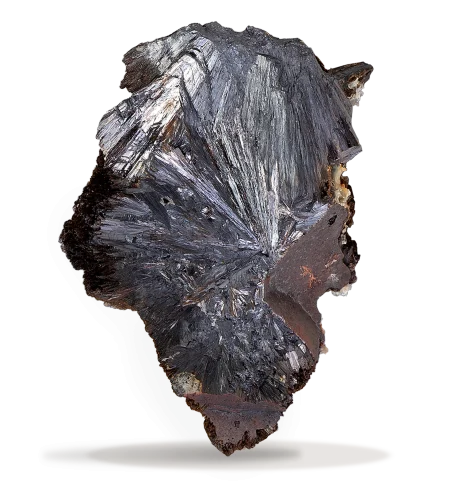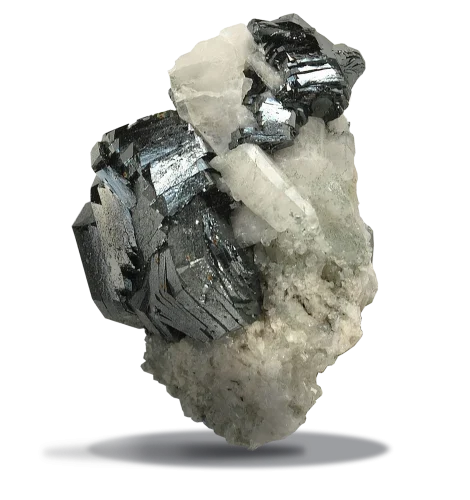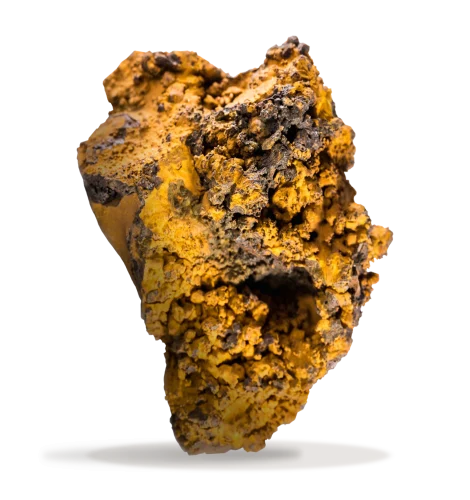

“Main Iron Ore Minerals”
Iron ore minerals are the primary source of iron, a metal vital to modern industrial society. The most economically significant iron ore minerals are hematite (Fe₂O₃), magnetite (Fe₃O₄), goethite (FeO(OH)), and siderite (FeCO₃). Hematite and magnetite are particularly prized due to their high iron content, with hematite containing up to 70% iron and magnetite up to 72%. These minerals differ in their physical properties: hematite is reddish-brown and non-magnetic, while magnetite is black and highly magnetic. Goethite (which is abundant in Ait Ammar mine), with its brownish-yellow hue, is softer and has a lower iron content, typically around 62%. The chemical and physical characteristics of these minerals determine their suitability for various industrial processes, particularly steelmaking.


Geologically, iron ore minerals are formed through diverse processes and are concentrated in specific types of deposits. The most common genesis includes banded iron formations (BIFs), sedimentary deposits (as in the Ait Ammar deposit) that developed in ancient marine environments over 2 billion years ago. BIFs contain alternating layers of iron-rich minerals and silica and are the source of major iron ore mines globally. Other significant deposits include magmatic iron ores formed through igneous processes and lateritic iron ores derived from weathering in tropical climates. These deposits are found in countries such as Australia, Brazil, Russia, and India, which dominate global iron ore production

Geologically, iron ore minerals are formed through diverse processes and are concentrated in specific types of deposits. The most common genesis includes banded iron formations (BIFs), sedimentary deposits (as in the Ait Ammar deposit) that developed in ancient marine environments over 2 billion years ago. BIFs contain alternating layers of iron-rich minerals and silica and are the source of major iron ore mines globally. Other significant deposits include magmatic iron ores formed through igneous processes and lateritic iron ores derived from weathering in tropical climates. These deposits are found in countries such as Australia, Brazil, Russia, and India, which dominate global iron ore production



Industries targeting iron ore prioritize properties such as high iron content, ease of processing, and low levels of impurities like phosphorus and sulfur. The steel industry, the largest consumer of iron ore, requires consistent ore quality to produce durable and cost-effective steel. Magnetite, for instance, is often processed into pellets to maximize its efficiency in blast furnaces. Additionally, the fine particle size and specific mineralogy of iron ores are critical in achieving the desired chemical reactions during smelting. As global demand for steel rises, the exploration and refinement of economically viable iron ore deposits remain a cornerstone of industrial development.
Production and Consumption Trends
Iron ore production is highly concentrated in a few countries, with Australia and Brazil leading the global output. However, the demand for iron ore has been expanding, particularly in Asia, where rapid urbanization and industrialization are driving the need for steel. Iron ore production has steadily increased over the years, driven by growing global demand for steel, which is primarily produced from iron ore.
Global Production
In 2023, global iron ore production is estimated to be around 2.5 billion metric tons. The major iron ore producing countries are:

Australia
Australia holds the largest iron ore reserves globally and is the largest exporter, with most of its iron ore going to China.

Brazil
Brazil’s iron ore reserves are the second largest, and the country is a top exporter.

China
While China is the largest importer of iron ore, it produces a significant portion of its own supply, mostly lower-grade ore.

India
India is a major producer and exporter of iron ore, although much of its production is consumed domestically as demand for steel rises.
Top Consumers
Iron ore consumption trends are closely tied to the production of steel, as it is the primary input for steelmaking. The key consumers of iron ore are:

China
China with 60% of global iron ore imports and having the largest steel industry in the world.

India
India with annual consumption of approximately 100–150 million metric tons, mostly for its rapidly expanding steel industry.

Japan
Japan importing around 50–60 million metric tons annually, Although Japan’s iron ore consumption has slightly declined due to demographic shifts and economic challenges

Other Countries in Europe
Other Countries in Europe (primarily Germany, Italy, and France), as well as the United States, also contribute to global consumption but in smaller quantities compared to the major consumers above.

South Korea
South Korea imports around 40–50 million metric tons of iron ore annually.


